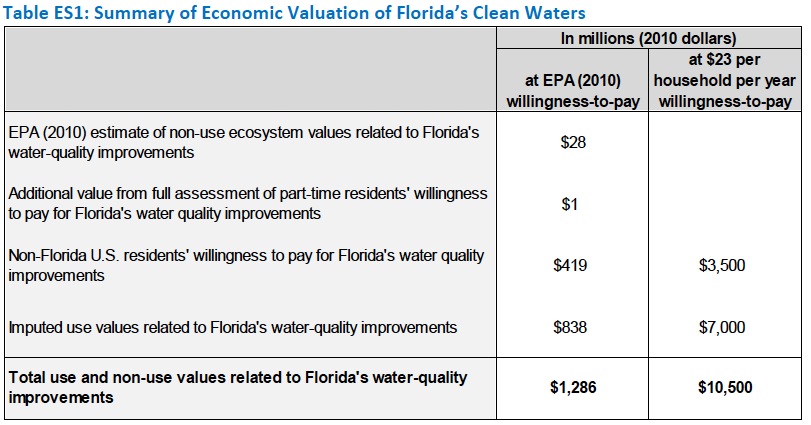STOCKHOLM ENVIRONMENT INSTITUTE
Executive Summary
In 1998 the EPA adopted the Clean Water Action Plan, which stated that excessive nutrient pollution results in greater than expected growth of macrophytes or phytoplankton, and potentially harmful algae blooms or outbreaks leading to declining oxygen levels, an imbalance among aquatic species, public health risks, and a general degradation of the aquatic resource. The “Key Action” for addressing nutrient over-enrichment was a requirement that states develop and implement numeric limits on the amount of so-called “nutrients” – phosphorus and nitrogen – allowed in waterbodies by the year 2004. If a state failed to do so, the EPA would establish criteria for them. As of 2008 the state of Florida had implemented just one such standard.
The EPA and the state of Florida’s failure to set numeric nutrient standards resulted in the filing of a lawsuit in 2008 with the intention of forcing their development and implementation. The plaintiffs, a coalition of environmental organizations represented by Earthjustice, claimed that the EPA was taking too long to establish the numeric nutrient criteria that the agency had already deemed necessary. The environmental groups argued that the EPA had an obligation to readily move forward with establishing and implementing such criteria in Florida. The EPA settled the litigation in August 2009, entering a consent decree with the plaintiffs, committing to have numeric nutrient criteria in place for Florida’s waterbodies by November 2010.
Water pollution from phosphorus and nitrogen is rapidly accelerated by human activity: population growth, together with agricultural and urban development, have led to large-scale wastewater discharges into aquatic environments. Nutrient pollution causes the gradual degradation, or eutrophication, of waterbodies. Ecological changes which otherwise might have occurred naturally over millennia instead have taken place in decades.
Nutrient pollution fuels the proliferation of harmful algae outbreaks. Excessive nitrogen and phosphorus in the water can make algae grow so quickly that ecosystems are overwhelmed by it. These high concentrations of algae have the potential to harm water quality, food resources and habitats, and reduce oxygen levels, making it more difficult for fish and other aquatic life to survive. Large growths of algae, called algae blooms, can result in illness or death of large numbers of fish by severely reducing or eliminating oxygen in the water. Some algae outbreaks produce toxins and bacterial growth that can make people ill from contact with polluted water, consumption of contaminated water, or tainted fish or shellfish.
The prevalence of harmful algae outbreaks throughout Florida was the central impetus for the Earthjustice lawsuit. The impacts of these events vary by species and intensity; some species, such as cyanobacteria and K. brevis, are toxic to humans and pets, and to other aquatic species, leading to respiratory difficulties, neurological issues, or food poisoning. Regardless of toxicity, harmful algae outbreaks have the potential to harm ecosystems by shading submerged vegetation and destroying aquatic habitats. Dense algae outbreaks often result in massive fish-kills by depleting the water’s oxygen levels. The evidence is now strong that many harmful algae blooms worldwide, in estuaries and coastal marine environments as well as freshwaters, are stimulated or supported by anthropogenic nutrient over-enrichment.
Rising levels of nutrients, in conjunction with increased water withdrawals, have been widely associated with human-induced pollution. As phosphorus and nitrogen are frequently the limiting factors in the growth of freshwater and saltwater algal species, nitrogen and phosphorus pollution tends to increase the potential for and severity of harmful algae outbreaks. Visitors and residents are deprived of their opportunity to fish, boat, and swim in public waters. The algae can produce dangerous toxins, emit noxious odors, adversely impact aquatic species, and degrade a water-body’s aesthetic qualities. Harmful algae outbreaks have real costs to society and reduce the value of ecosystem services provided by Florida’s waters.
The valuation of Florida’s clean water presented in this report led to a range from $1.3 to $10.5 billion dollars annually (see Table ES1). The methodology used to provide this estimation, however, was based on a willingness-to-pay for non-use values that – while generated from a well-accepted method frequently used by the EPA – are not built from Florida-specific economic analysis, and a generic imputation of use values drawn from relationships presented in the literature.
Download full report (PDF): Valuing Florida’s Clean Waters
About the Stockholm Environment Institute
www.sei-international.org
“SEI is an independent international research institute. We have been engaged in environment and development issues at local, national, regional and global policy levels for more than 20 years.“
Tags: FL, Florida, SEI, SEI-International, Stockholm Environment Institute







 RSS Feed
RSS Feed